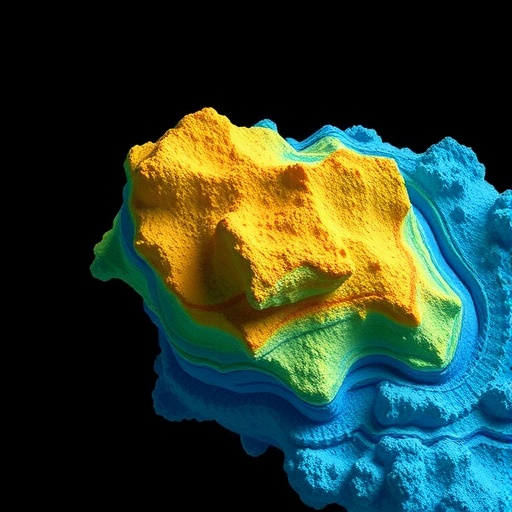Deep-sea polymetallic sulfide deposits are becoming a focus of intense research due to their potential to supply essential metals for emerging technologies. A groundbreaking study led by Zhao, Q., Yu, S., and Wang, L. has introduced innovative methodologies for the recognition and assessment of these deposits through advanced image enhancement and semantic segmentation strategies. Their work, published in Natural Resources Research, represents a significant step towards unlocking the vast mineral wealth located beneath the ocean’s surface.
Polymetallic sulfides are primarily found at hydrothermal vent systems on the ocean floor, enriched with valuable metals such as copper, gold, silver, and rare earth elements. However, the challenge lies in accurately identifying and quantifying these deposits amid the harsh underwater environment and complex geological formations. Traditional methods of exploration often fall short in efficiency and precision, which is where the novel techniques introduced by Zhao and colleagues come into play.
The researchers utilized state-of-the-art image enhancement techniques to improve the visual quality of data gathered from underwater imaging systems. This improvement allows for clearer detection of target mineral deposits which might otherwise be obscured. By enhancing the image quality, the research team was able to discern finer details and textures, providing a more accurate representation of the seafloor and its resource potential.
Next, the study employed semantic segmentation strategies, leveraging artificial intelligence and machine learning algorithms to classify and identify various geological features on the seafloor. This method divides the visual information into distinct segments, facilitating the identification of polymetallic sulfide deposits with higher accuracy compared to conventional approaches. The integration of semantic segmentation represents a transformational shift in the way researchers analyze underwater imagery, enhancing both speed and precision.
One of the highlights of this research is the capacity to automate the analysis process. By employing intelligent recognition systems, the researchers achieved a significant reduction in the time required to process and interpret underwater imagery. This breakthrough could drastically improve exploration efficiency, allowing for more comprehensive assessments of seafloor resource potential, ultimately leading to increased exploration in previously uncharted areas.
The methodology proposed in this study also opens the door for further advancements in underwater technology. As researchers continue to refine and optimize these image processing techniques, the implications could extend far beyond the realm of polymetallic sulfide mining, impacting various fields such as marine biology and environmental monitoring. The accurate assessment of mineral deposits is not only vital for resource acquisition but also for ensuring sustainable practices as we explore the ocean’s depths.
In addition to technical advancements, the socio-economic implications of this research cannot be overlooked. As the demand for metals rises with the expansion of technology and renewable energy solutions, understanding where and how to responsibly gather these resources becomes critical. The findings of Zhao and colleagues provide a framework that may help balance resource extraction with ecological preservation in sensitive marine environments.
Furthermore, the study highlights the importance of interdisciplinary approaches in modern research. The successful integration of geology, computer science, and environmental studies bolsters the need for collaboration among experts from various fields. This collaborative spirit is essential to tackle the challenges associated with deep-sea exploration and resource management efficiently.
The validation of these methods in real-world scenarios will be crucial for the future of underwater exploration. As field trials of the proposed systems take place, researchers anticipate gathering more data that will further enhance the algorithms and techniques described in the study. Such empirical validation is essential for refining methodologies and ensuring that the technologies developed can perform effectively in the varying conditions present in deep-sea environments.
The implications of this research also extend beyond the immediate field of mineral extraction. By improving resource assessment techniques, we can glean insights into the geological processes that govern the formation of these deposits. Understanding these processes can inform future exploration efforts and aid in the sustainable development of ocean resources.
As global interest in deep-sea mining grows, regulatory frameworks will need to evolve to address the complexities introduced by advanced technological applications like those presented in this study. Policymakers will need to engage with scientific communities to establish guidelines that ensure the safe and responsible extraction of resources while safeguarding marine ecosystems.
In conclusion, the innovative strategies developed by Zhao, Q., Yu, S., and Wang, L. mark a pivotal advancement in the intelligent recognition and assessment of deep-sea polymetallic sulfide deposits. With continued research and field application, these methodologies promise to enhance our understanding of underwater resources, improve exploration efficiency, and contribute to the sustainable management of ocean riches for future generations.
Subject of Research:
Article Title: Intelligent Recognition and Efficient Resource Assessment of Deep-Sea Polymetallic Sulfide Deposits Using Image Enhancement and Semantic Segmentation Strategies
Article References:
Zhao, Q., Yu, S., Wang, L. et al. Intelligent Recognition and Efficient Resource Assessment of Deep-Sea Polymetallic Sulfide Deposits Using Image Enhancement and Semantic Segmentation Strategies. Nat Resour Res (2025). https://doi.org/10.1007/s11053-025-10552-4
Image Credits: AI Generated
DOI:
Keywords:




